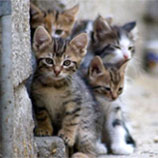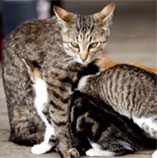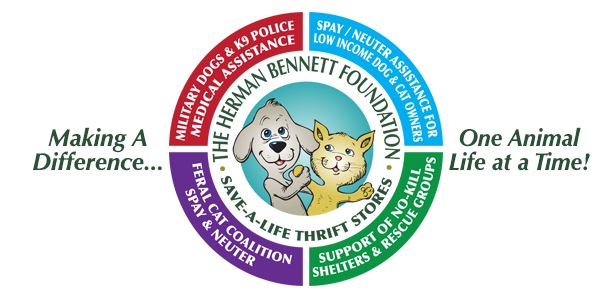Feral Cats – Find, Report, Trap & More
Community Cats Charity | Report A Colony | More Info About Feral Cats
Found a Kitten?
Leave These Alone (Dejarlos solos)

Kittens not walking should be left with the mother cat. She will provide the best care. Provide fresh water and food for the mother cat far away from the kittens. Food may attract predators to the kittens.
Los gatitos que no caminan se dejan con la mamá gata. Ella proporcionara la mejor atención. Proporciona agua fresca y comida para la mamá gata una distancia de los gatitos. Los alimentos pueden atraer a lost depredadores a los gatitos.
Rescue These (Rescatarlos)

Take walking kittens to your local cat rescue or shelter. They will be fostered and adopted to a good home. Kittens dehydrate fast so catch and deliver on the same day.
Lleve gatitos que pueden caminara un rescate o refugio local. Ellos seránfomentadosyadoptadosaun buen hogar. Los gatitos se deshidratan rapidamente. Captura y entrega en el mismo día.
Spay Her (Esterilizarla)

Mother cat will get pregnant again when her kittens leave so catch her and get her spayed quickly. There are low cost and free ways available to get the mother cat spayed (805) 584-3823. Return mother cat where she was after being spayed.
Mamá gata seem barazaráde nuevo cuando sus gatitos se van, asi que cogerla y conseguir esterilizamiento rapidamente. Hay bajo costo y maneras libres disponibles para obtener esterilización para la mamá gata. (805)584-3823 Devuelve a la mamá gata donde estaba después de ser esterilizada.

Although a cat in your yard could be a neighbor’s cat or a stray, it might very well be a feral cat. What is a feral cat and how is it different from a stray cat?
Feral cats typically avoid people and can’t be touched. These cats usually live outdoors in groups known as colonies. While stray cats have had human contact at some point, they have become displaced and may also become feral. Both ferals and strays may also be called community cats.
Traditionally, the method of feral cat control has been to trap and euthanize the cats. There is a common misconception that once these cats are trapped and removed from a neighborhood, the cat problem will go away.
The reality is that trapping and removing cats won’t resolve the cat problem. This method has proven ineffective because the food source (dumpsters, garbage, rodents, etc.) usually remains. As a result, other cats eventually find their way into your neighborhood and will quickly repopulate the area.
TNR is the most successful and proven method of reducing feral cat populations. TNR involves the careful trapping, spaying or neutering, and vaccination of the cats.
The feral cats are then returned to their original location. Any cats or kittens that are social enough will be removed and placed for adoption. The number of existing cats is reduced, and because there will be no more kittens, the colony becomes stable.
If you’re already feeding neighborhood feral cats, and you’d like to continue feeding the returned cats after TNR, or even help with the TNR, please complete the "I Want To Report A Colony" form and be sure to check "yes" in the box that asks if you consider yourself the colony caregiver. We will help you find resources to TNR the colony.
Other Resources and Ways You Can Help
If you are a caretaker for a colony, or you have encountered a colony (group of cats) that appear to be stray or feral, please help by reporting them.
If you come across some stray or feral cats, t's possible that someone may already be doing Trap/Neuter/Return (TNR) at that location. By reporting any groups of cats you encounter, we can check to see if they are already being managed.
If the cats are not being cared for, it's important that someone steps up to help control the population before it gets out of hand. Perhaps you’d like to help with the TNR effort? We are here to provide you with all the necessary information for success.
To help us collect information about the size and location of the colony, click here, "Report a Colony" and send in the form.
If you have found tame cats or kittens in your yard or nearby that do not appear to "belong" to anyone, here are some tips for helping them.
If you’ve found tiny kittens without an apparent mother
Note: Tiny kittens taken to the animal shelters are generally euthanized because they are too young to be adopted, and shelters do not have the staff to provide the intense care that a very young kitten needs to survive. These resources are intended to provide guidance to those who wish to give these kittens a chance to survive and be adopted.
- Leave the kittens in place for 6-12 hours and see if the mother cat returns. Female cats tend to move their kittens at least every week for safety. It often takes them all day to move all of the kittens to the new location, so the kittens you've found may just be waiting for their mother to return. Check with your neighbors and post flyers in your neighborhood in an attempt to find the owner.
- If the mother cat returns and she is friendly,take her and the kittens inside and allow the mother to care for the kittens until they are between 5-8 weeks of age. At 5 weeks of age, the mother cat can be spayed and the kittens will be able to eat solid food. The kittens can be altered at 8 weeks of age. See below for Spaying & Neutering resources.
- If the mother cat returns but is feral, please report the feral colony.
- If the mother cat does not return with 6 - 12 hours, bring the kittens inside. Provide a heat source such as a heating pad on low setting. Immediately give drops of water slowly by mouth from an eye dropper or syringe to hydrate the kittens and refer to the Alley Cats Allies website for information on caring for kittens.
Once the kittens reach 8 weeks of age, they can be altered (see below for Spaying & Neutering resources) and adopted to friends and family. Or, if you do not wish to alter and adopt the kittens, they can be taken the animal shelter. Once they are weened, the kittens have a better chance of surviving at the shelter.
If you’ve found a cat
- If the cat is a female, check if it is nursing kittens by feeling for enlarged nipples on the cat’s belly. If you find that the cat is nursing kittens, return the cat to your yard and attempt to follow her to her kittens. (see “Kitten” information, above).
- Check for a collar with tags.
- Scan the cat for a microchip. Take the cat to a veterinarian or animal shelter and ask them to do this. There is NO CHARGE for this service.
- Check with your neighbors and post flyers in your neighborhood.
- Post the cat on the Lost and Found section of Craig’s List (craigslist.com), a free, on-line resource. NEVER offer a cat for FREE on any websites. Always screen potential adopters! There are many unscrupulous people looking for "free" animals to be used in numerous inhumane ways. Be sure to read Craigslist's guidelines about returning an animal to the stated owner. Use care, and attempt to confirm ownership through vet or other records to avoid the animal falling into the wrong hands.
- If the cat is not nursing and you are unable to find the owner, you can get the cat fixed (see Spaying & Neutering, below, for resources) and adopt it to friends or family, or take the cat to your local animal shelter.
- There are many resources for low-cost spay-neuter. Cats and kittens can be altered once they reach two pounds or 8 weeks of age. They can be taken to the animal shelter or altered and adopted to friends.
- Please do not give away any animal to others without getting them spayed or neutered first. Even if you're able to locate the owner of an animal or if, during your search, you find someone who would like to take the animal, please strongly encourage them to have the animal fixed first.
A lot of people think the only way to deal with feral cats is to get rid of them... and sometimes it's hard to convince those people otherwise. If you understand the importance of maintaining feral colonies but need help convincing others, we have a team of trained educators who can contact building owners, managers, neighbors and others where feral colonies reside.
Our skilled team can provide resolutions to conflicts surrounding feral cats and colonies. We can also provide you with specific documents or guidance on how to talk with people on these issues.
You can help improve the lives of feral cats in our community. If you want to learn about feral cats and how to help them, and you are a cat person or care about animals, contact us about volunteering.


